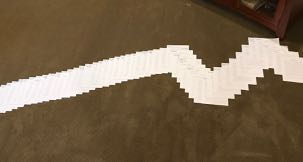
After years of creating the puzzle, making sure all the pieces fit perfectly, it became time to embrace the unthinkable: Throw out a third of the pieces, and reorder the rest into the same story, only different.
The challenge was immediately apparent – I’d spent so long coming to understand the story in one specific way I’d lost the ability to see how it could be improved by cutting certain scenes, or how moments could be combined to keep the pace moving. Then there was the insecurity – what if I cut a scene that had some important subplot, or breadcrumb critical to later story happenings? I needed a way to make sure nothing essential fell through the cracks during the revision process. Not to mention the sense of overwhelm when I thought about the work involved in the revision I was contemplating.
I needed a new perspective, a safety net, and a way to bypass the inner critic. Here’s what worked for me . . .
I printed out the entire story, single sided. I stapled together each scene or chapter, so I could move story moments in discrete blocks. In the upper left hand corner I wrote why the scene or chapter was essential – what plot point happened, and what character emotional growth was realized. I used blue pen for these notes. In the upper right hand corner, I noted any breadcrumbs, foreshadowing, or subplot elements I wanted to keep in mind. I used purple for these, just to keep them visually distinct.
Then I started to place chapters on the floor by guessing generally where they might fall in the re-envisioned story. I had in mind that I would create a plot map on the floor of my living room. I set aside any scenes that I was considering cutting, thought I might be able to merge with others, or ones that seemed thin on blue corner notes (those that perhaps didn’t have character development or a plot reason for being in the story). As I added more scenes, I shifted things around, and sometimes doubled up on possible mash-ups (I paper clipped these together).
The end result is the photo above – a large scale plot map that I could stack up in order, and use as a guide when I went back to the file and started moving things around. I had a stack of scenes to cut – which I moved into a new filed named “Revision Dump Doc” – they were there if I needed them, but weren’t cluttering up the story any more. Lastly, there was a stack of scenes that I didn’t need, but contained a breadcrumb or subplot element that needed to be incorporated elsewhere. This worked to help me keep in mind the larger picture as I worked through the revision, and gave me the peace of mind that nothing important was going to be lost in the shuffle.
Have you taken on a large scale revision? If so, what worked for you? Share your ideas in the comments section below! And above all, #WriteOn.